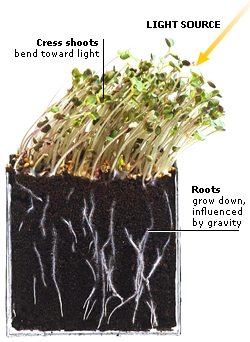DK Science: Plant Sensitivity
Like animals, plants sense changes in their surroundings and respond to them. Plants are able to detect and respond to light, gravity, changes in temperature, chemicals, and even touch. Unlike animals, plants do not have nerves or muscles, so they cannot move very fast. A plant usually responds to change by gradually altering its growth rate or its direction of growth. The slow movements that plants make towards or away from a stimulus, such as light, are known as tropisms. Tropisms are controlled with the help of special chemicals called PLANT GROWTH REGULATORS.

Light influences how shoots grow. They bend towards it, so that leaves will have the maximum amount for photosynthesis. Roots push down through soil because of the effect of gravity. They may also be drawn towards water, or away from bright light. Other factors, such as temperature and how wet the soil is, may affect when seeds germinate (sprout).

Over the course of a day, the flowerheads in a field of sunflowers gradually turn, tracking the Sun’s path across the sky. The movement is almost too slow to notice. In the morning, the flowerheads all face east and by evening they face west. This is called phototropism, which means the movement of part of a body towards light. It happens as chemicals shift from one side of the stems to the other.
Many plants only bloom at certain times of year. They flower at the right time by responding to changes in light and temperature. A crocus plant is able to detect signs of spring, such as lengthening days (more light) and warmer soil (increased temperature). These changes cause chemical changes in the plant and the crocus starts to put out shoots and flowers.
Deciduous plants such as Forsythia respond to the lack of light and warmth in winter by entering a resting period. In preparation, the plant produces chemicals that weaken the leaf stalks, so the leaves fall. Over winter, the plant does not need to make food. Its shoots and buds are inactive. When spring comes, the plant produces chemicals that make buds and shoots start to grow again.
Some plant parts respond to contact. Climbers, such as pea plants and this passion flower, put out long, reaching shoots called tendrils. When a tendril reaches something solid – such as a garden cane or the stem of another plant – it coils around it. By grasping at supports in this way, the plant is able to climb even higher.
Roots usually respond to light by growing away from it, but the roots of mangrove trees behave differently. Mangroves grow in coastal swamps where there is little oxygen in the waterlogged soil. Their roots compensate for this by growing upwards out of the mud. Each low tide, the mangrove roots are exposed to the air and can collect plenty of oxygen.
Certain chemicals influence different aspects of a plant’s growth. These plant growth regulators may control how fast cells divide, or how they grow. Some are produced in the tips of shoots or roots. They can even change the direction the shoot or root takes as it grows. If cells on one side of the tip grow faster, the tip will start to curl in the opposite direction.
